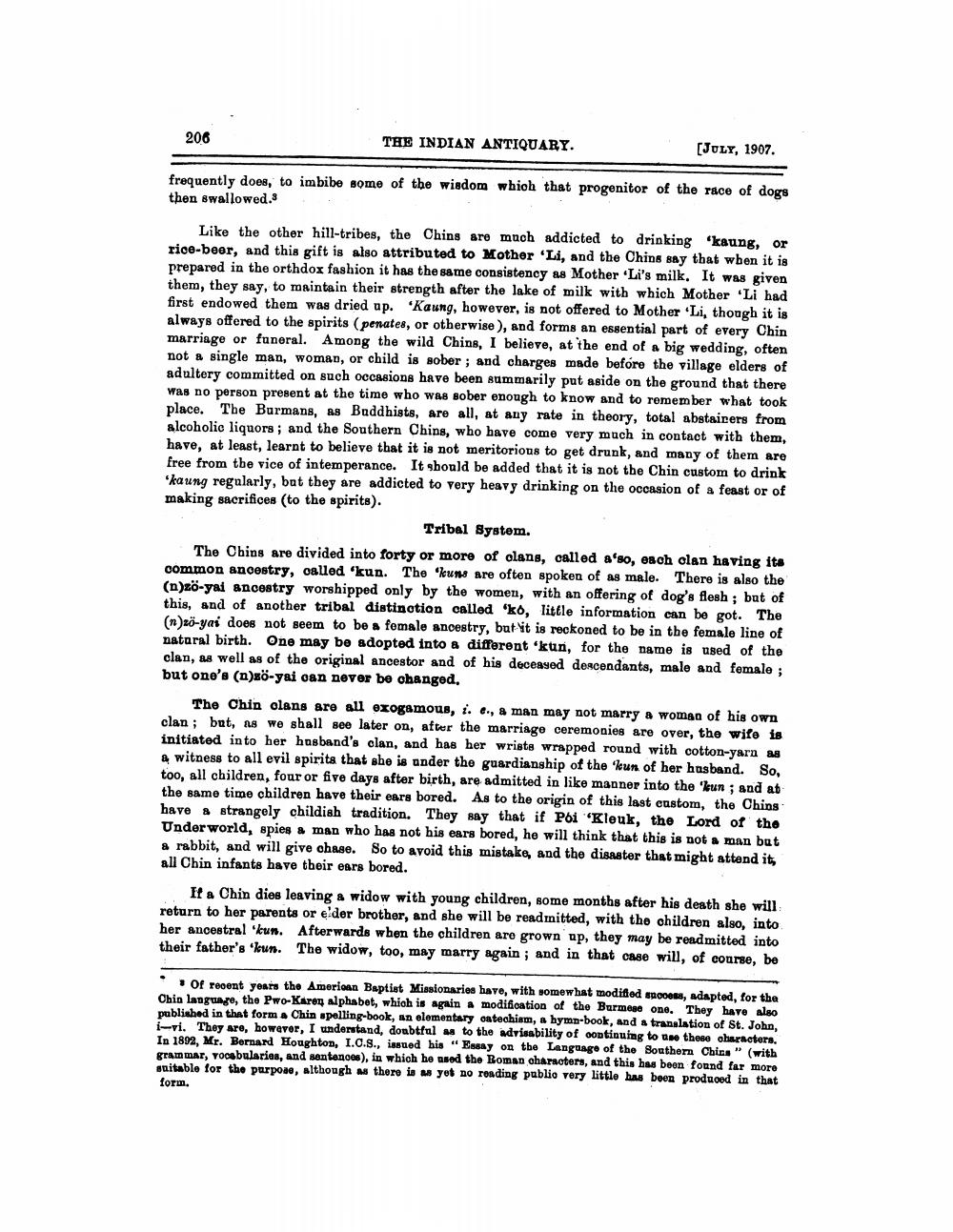________________
206
THE INDIAN ANTIQUARY.
[JULY, 1907.
frequently does, to imbibe some of the wisdom which that progenitor of the race of dogs then swallowed.3
Like the other hill-tribes, the Chins are much addicted to drinking "kaung, or rice-beer, and this gift is also attributed to Mother 'Li, and the Chins say that when it is prepared in the orthdox fashion it has the same consistency as Mother 'Li's milk. It was given them, they say, to maintain their strength after the lake of milk with which Mother 'Li had first endowed them was dried up. 'Kaung, however, is not offered to Mother 'Li, though it is always offered to the spirits (penates, or otherwise), and forms an essential part of every Chin marriage or funeral. Among the wild Chins, I believe, at the end of a big wedding, often not a single man, woman, or child is sober; and charges made before the village elders of adultery committed on such occasions have been summarily put aside on the ground that there was no person present at the time who was sober enough to know and to remember what took place. The Burmans, as Buddhists, are all, at any rate in theory, total abstainers from alcoholic liquors; and the Southern Chins, who have come very much in contact with them, have, at least, learnt to believe that it is not meritorious to get drunk, and many of them are free from the vice of intemperance. It should be added that it is not the Chin custom to drink kaung regularly, but they are addicted to very heavy drinking on the occasion of a feast or of making sacrifices (to the spirits).
Tribal System.
The Chins are divided into forty or more of clans, called a'so, each clan having its common ancestry, called 'kun. The 'kuns are often spoken of as male. There is also the (n)zö-yai ancestry worshipped only by the women, with an offering of dog's flesh; but of this, and of another tribal distinction called 'ko, little information can be got. The (n)zö-yai does not seem to be a female ancestry, but it is reckoned to be in the female line of natural birth. One may be adopted into a different 'kun, for the name is used of the clan, as well as of the original ancestor and of his deceased descendants, male and female; but one's (n)sö-yai can never be changed.
The Chin olans are all exogamous, i. e., a man may not marry a woman of his own clan; but, as we shall see later on, after the marriage ceremonies are over, the wife is initiated into her husband's clan, and has her wrists wrapped round with cotton-yarn as a witness to all evil spirits that she is under the guardianship of the 'kun of her husband. So, too, all children, four or five days after birth, are admitted in like manner into the 'kun; and at the same time children have their ears bored. As to the origin of this last custom, the Chins have a strangely childish tradition. They say that if Pói 'Kleuk, the Lord of the Underworld, spies a man who has not his ears bored, he will think that this is not a man but a rabbit, and will give chase. So to avoid this mistake, and the disaster that might attend it, all Chin infants have their ears bored.
If a Chin dies leaving a widow with young children, some months after his death she will return to her parents or elder brother, and she will be readmitted, with the children also, into her ancestral 'kun. Afterwards when the children are grown up, they may be readmitted into their father's 'kun. The widow, too, may marry again; and in that case will, of course, be
Of recent years the American Baptist Missionaries have, with somewhat modified success, adapted, for the Chin language, the Pwo-Karen alphabet, which is again a modification of the Burmese one. They have also published in that form a Chin spelling-book, an elementary catechism, a hymn-book, and a translation of St. John, i-vi. They are, however, I understand, doubtful as to the advisability of continuing to use these characters. In 1892, Mr. Bernard Houghton, I.C.S., issued his "Essay on the Language of the Southern China" (with grammar, vocabularies, and sentences), in which he used the Roman characters, and this has been found far more suitable for the purpose, although as there is as yet no reading public very little has been produced in that
form.




